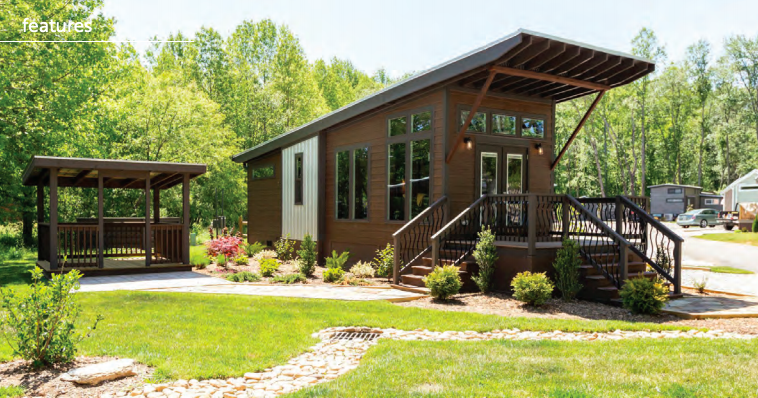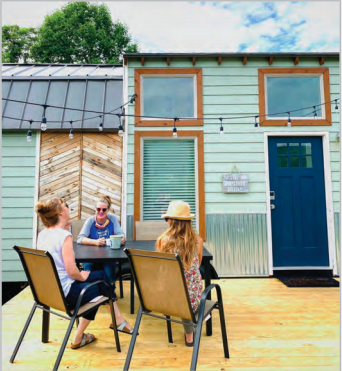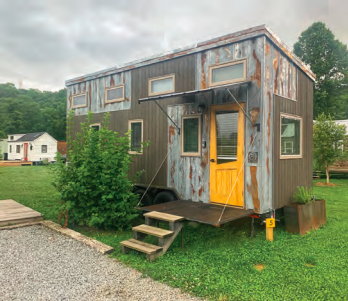Tiny-home living has been growing in popularity over the past decade, and the advent of the coronavirus crisis may intensify that surge.
With modern society craving more time outdoors and more money for travel and leisure, tiny homes offer a lot of advantages.
“Designing my tiny home was really fun,” said Jacki Yates, a resident of Acony Bell Tiny Home Community, which is nestled in a wooded 60 acres in Mills River. “The design depends on the type of storage you need and how you’ll use your space the most.”
Yates, a longtime road biker and Ironman triathlete, works from home and needed space to store bikes. During her design phase, she factored in these two important components. In the summer of 2020, Yates married her husband, Sam, an avid mountain biker, and her tiny home’s bike storage became even more useful.
Yates says living in her tiny-home community is like being at camp all the time. She and her husband are good friends with the other residents and often enjoy potluck dinners, campfires, board games and community gardening.

Acony Bell
Acony Bell co-founders Mark Brooks and John Monroe developed the village specifically for tiny houses on wheels and outdoor enthusiasts. On site, residents enjoy mountain biking trails, fishing, hiking and edible gardens. There are even hop vines strategically planted around electrical units to beautify each site.
Acony Bell is a blend of permanent residents and vacation rentals. Since each demographic has different needs and desires, the two sections are separated on the property.

“When we acquired this plot of land, we were originally thinking of an RV park,” said Brooks, a civil engineer and president of Brooks Engineering. “That was around the time tiny homes were getting popular. We went to a few tiny-home shows and thought they were really cool, so we decided to go the tiny-home route.”
All of the structures at Acony Bell are tiny homes on wheels, also known as a THOW. The goal for Brooks and Monroe was to have an eclectic blend of homes designed by a realm of builders throughout the region.
“We don’t want to sell you a house,” said Monroe, property manager at Acony Bell. “We can help you design the home, but we want our residents to have control of the details. Also, we want to support local and regional tiny home builders and put money back in the economy. With that being said, each tiny-home owner chooses their builder so they get what they want.”
The Village
Down the road from Acony Bell is The Village at Flat Rock, another tiny-home community which operates under a different paradigm but with a similar comprehensive goal.
“More and more people are reevaluating what’s important to them,” said Coles Carangian, marketing director for The Village at Flat Rock. “They’re realizing all that living space they’re trying to maintain may not be worth it.”

The Village at Flat Rock is one of several small cottage home villages managed by the umbrella company Simple Life. Company founders, The Resource Group, have been in land development and homebuilding for two decades. They realized there was a need for affordable, low-maintenance housing for a particular demographic – homeowners who wanted nice home features and amenity-rich living. This realization combined with the tiny-home movement was the impetus for Simple Life.
Currently, Simple Life operates two sites, one in Flat Rock and one in Central Florida. They recently broke ground on a second community in Henderson County. At The Village, residents select from a handful of designs. They own their home and lease the land. Additionally, the community offers amenities such as a swimming pool, clubhouse, social events and an all-inclusive service cost with landscaping, cable, water and trash pick-up.
Sustainability and ordinances
Acony Bell and The Village at Flat Rock both strive to embrace sustainability. All homes in The Village at Flat Rock are manufactured indoors then brought on-site. This decreases construction waste and improves the air quality of the dwelling. Many of the Acony Bell residents select builders known for their green-building prowess.Tiny homes are known for producing a relatively small carbon footprint and using less energy due to reduced space to heat and cool.
Ordinances can be tricky when it comes to tiny-home living. Depending on location, zoning restrictions may inhibit tiny-home goals. A tiny home with a foundation is more likely to be approved for residential use, unless a piece of land is leased like those offered at Acony Bell, which fully welcomes homes on wheels. A THOW may not qualify as a house because there’s no structural foundation. Further, some places require a minimal square footage, which challenges the basic concept of a tiny home.

Another choice to consider is an accessory dwelling unit (ADU), which is a tiny home on the same property as a standard-sized residence. Homeowners routinely use these for guest houses or rentals.
An ADU is often preferred over a tiny home serving as a primary residence. When the tiny home is the only dwelling on a piece of property, it can lower the tax value of the land. Further, neighbors often frown upon a single tiny house among larger homes due to aesthetics or an anticipated decrease in value in their own home.
Some states are more amenable to tiny-home living than others. Architect Magazine ranked the top five states for tiny homes as California, Oregon, Texas, North Carolina and Florida. This assessment was based on a multitude of factors, including zoning laws, ordinances, access to information, number of tiny-home communities and the prevalence of builders focusing on tiny homes and ADUs.
The tiny-home industry is growing and evolving, but ordinances, zoning laws and human resistance to change can make that movement slow going. Nonetheless, for folks like Yates and her husband, a tiny home is exactly what they need.
“I like how living in a small space forces a person outdoors,” Yates said. “We absolutely love the area and Acony Bell. We plan on sticking around for quite a while.”
You can also view this article as it was originally published on pages 52-53 of the 2020-2021 edition of the directory.

